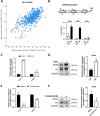The DNA/RNA helicase DHX9 contributes to the transcriptional program of the androgen receptor in prostate cancer
- PMID: 35590370
- PMCID: PMC9118622
- DOI: 10.1186/s13046-022-02384-4
The DNA/RNA helicase DHX9 contributes to the transcriptional program of the androgen receptor in prostate cancer
Abstract
Background: Prostate cancer (PC) is the most commonly diagnosed male malignancy and an important cause of mortality. Androgen deprivation therapy is the first line treatment but, unfortunately, a large part of patients evolves to a castration-resistant stage, for which no effective cure is currently available. The DNA/RNA helicase DHX9 is emerging as an important regulator of cellular processes that are often deregulated in cancer.
Methods: To investigate whether DHX9 modulates PC cell transcriptome we performed RNA-sequencing analyses upon DHX9 silencing in the androgen-responsive cell line LNCaP. Bioinformatics and functional analyses were carried out to elucidate the mechanism of gene expression regulation by DHX9. Data from The Cancer Genome Atlas were mined to evaluate the potential role of DHX9 in PC.
Results: We found that up-regulation of DHX9 correlates with advanced stage and is associated with poor prognosis of PC patients. High-throughput RNA-sequencing analysis revealed that depletion of DHX9 in androgen-sensitive LNCaP cells affects expression of hundreds of genes, which significantly overlap with known targets of the Androgen Receptor (AR). Notably, AR binds to the DHX9 promoter and induces its expression, while Enzalutamide-mediated inhibition of AR activity represses DHX9 expression. Moreover, DHX9 interacts with AR in LNCaP cells and its depletion significantly reduced the recruitment of AR to the promoter region of target genes and the ability of AR to promote their expression in response to 5α-dihydrotestosterone. Consistently, silencing of DXH9 negatively affected androgen-induced PC cell proliferation and migration.
Conclusions: Collectively, our data uncover a new role of DHX9 in the control of the AR transcriptional program and establish the existence of an oncogenic DHX9/AR axis, which may represent a new druggable target to counteract PC progression.
© 2022. The Author(s).
Conflict of interest statement
The authors declare that they have no competing interests.
Figures






Similar articles
-
Src promotes castration-recurrent prostate cancer through androgen receptor-dependent canonical and non-canonical transcriptional signatures.Oncotarget. 2017 Feb 7;8(6):10324-10347. doi: 10.18632/oncotarget.14401. Oncotarget. 2017. PMID: 28055971 Free PMC article.
-
The DNA/RNA helicase DHX9 orchestrates the KDM2B-mediated transcriptional regulation of YAP1 in Ewing sarcoma.Oncogene. 2024 Jan;43(4):225-234. doi: 10.1038/s41388-023-02894-1. Epub 2023 Nov 28. Oncogene. 2024. PMID: 38017132
-
The androgen receptor-lncRNASAT1-AKT-p15 axis mediates androgen-induced cellular senescence in prostate cancer cells.Oncogene. 2022 Feb;41(7):943-959. doi: 10.1038/s41388-021-02060-5. Epub 2021 Oct 19. Oncogene. 2022. PMID: 34667276 Free PMC article.
-
Androgen receptors in hormone-dependent and castration-resistant prostate cancer.Pharmacol Ther. 2013 Dec;140(3):223-38. doi: 10.1016/j.pharmthera.2013.07.003. Epub 2013 Jul 13. Pharmacol Ther. 2013. PMID: 23859952 Review.
-
Understanding the mechanisms of androgen deprivation resistance in prostate cancer at the molecular level.Eur Urol. 2015 Mar;67(3):470-9. doi: 10.1016/j.eururo.2014.09.049. Epub 2014 Oct 8. Eur Urol. 2015. PMID: 25306226 Free PMC article. Review.
Cited by
-
Genome-wide mapping of native co-localized G4s and R-loops in living cells.Elife. 2024 Oct 11;13:RP99026. doi: 10.7554/eLife.99026. Elife. 2024. PMID: 39392462 Free PMC article.
-
Regulation and mechanisms of action of RNA helicases.RNA Biol. 2024 Jan;21(1):24-38. doi: 10.1080/15476286.2024.2415801. Epub 2024 Oct 22. RNA Biol. 2024. PMID: 39435974 Free PMC article. Review.
-
Cooperation between SIX1 and DHX9 transcriptionally regulates integrin-focal adhesion signaling mediated metastasis and sunitinib resistance in KIRC.Oncogene. 2024 Sep;43(39):2951-2969. doi: 10.1038/s41388-024-03126-w. Epub 2024 Aug 22. Oncogene. 2024. PMID: 39174859
-
Synthetic lethal interactions of DEAD/H-box helicases as targets for cancer therapy.Front Oncol. 2023 Jan 26;12:1087989. doi: 10.3389/fonc.2022.1087989. eCollection 2022. Front Oncol. 2023. PMID: 36761420 Free PMC article. Review.
-
Targeting DHX9 Triggers Tumor-Intrinsic Interferon Response and Replication Stress in Small Cell Lung Cancer.Cancer Discov. 2024 Mar 1;14(3):468-491. doi: 10.1158/2159-8290.CD-23-0486. Cancer Discov. 2024. PMID: 38189443 Free PMC article.
References
MeSH terms
Substances
Grants and funding
LinkOut - more resources
Full Text Sources
Medical
Molecular Biology Databases
Research Materials
Miscellaneous

